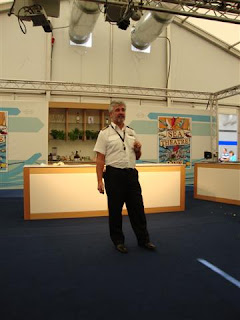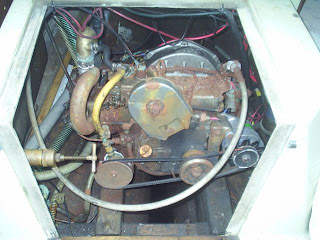My Snapdragon 27 Yacht is fitted with a Yanmar YSE12 Engine. This is very similar to the Yanmar YSM, YSE8, YSB8, YSB12 Engine.
I am going to rebuild the engine and will document the process on this website.
The 'E', 'B', 'M' I believe stand for 'Early' 'Between' 'Modern' versions of the engine. The YSE & YSB are very similar, with the YSM having a different design and ancillaries. The main difference I have noticed on the YSE and YSB is the thermostat housing or 'Water jacket', on the top of the engine. There is an identifying plate on top of the flywheel housing.
Originally designed as a flat twin, made by Coventry Climax in the mid 1930s; designed to go in the stern of landing craft, these engines were made so servicing could be from the front, the engines low height allowing them to be tucked away in the stern. Yanmar made the modified design for a single in 1974, making the YSE from 1974 to 1977. Modifications were made for the YSB for 1 year, before a redesign, including a different fuel injection pump for the production of the YSM from 1978 until ceasing production in 1980.
The YSE & B have a fuel injection pump bolted onto the front of the engine, while the YSM has a different type of pump, which is bolted in the cylinder block. Another difference is the front pulley is on a layshaft on the YSE & B, only being on the crankshaft on the YSM.
The engine is raw water cooled only, so operates at a low temperature. The engine should not be run slowly for long periods; the manual states to run flat out for an hour after trawling for a few hours. The oil level can be critical, as reports of oil blow by causing the engine to race out of control seem common. This is when the engine runs on it's own lubricating oil, instead of the diesel fuel.
The engine has no oil filter, relying on an oil strainer. This consists of a series of thin rings on a shaft that is turned by a T handle on the front of the engine. Thin plates between the rings; scrape the debris from the oil. The dipstick is on the oil filler, both for the engine and gearbox. Levels should be taken with the screw filler caps resting on the threads, not screwed in. Care should be taken however, as the engines are not always mounted level in the boat.
The manual states 30sae oil, but multigrade oil can be used, as this oil is superior, and was not around when the engine was manufactured. Care should be taken to only use a mineral oil, and not one of the synthetic, or semi-synthetic oils around today. These can damage the bearings of older engines.
The YSE and B have a poorly designed govenor. A needle valve in the pump releases the injection pressure, hence only about 1/3 of a turn of a fine threaded bolt is required from full throttle to stop. After all these years, the needle valve seats are worn in the pumps, causing erratic running, stopping, and poor starting. New needle valves are readily available though.
The gearbox of the YSEs can be 2 to 1 or 3 to 1 reduction (3 to 1 has a 'G' designation at the end of the engines model number of chasis plate). The reverse is very slightly lower geared, but on mine with 2 to 1 gearing, there is little noticeable difference in engine speed. The engines maximum speed is specified as3000 rpm.
The engine is noisy engine, however it is economical, using approx. 1 to 1 1/2 litres of diesel an hour.
Despite their age, parts are still readily available for these engines, although the cost of repair is becoming uneconomic in some cases, according to some people I have been in contact with.
The majority of this information came from:
http://www.angelfire.com/rnb/malcsworld/boat/YanmarYSengines.html










































